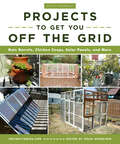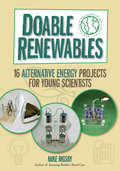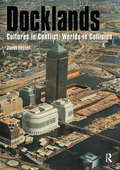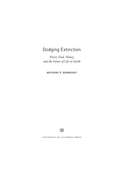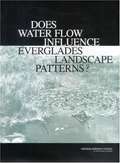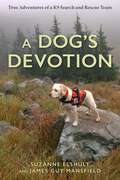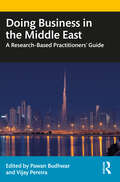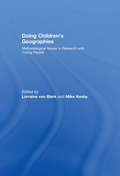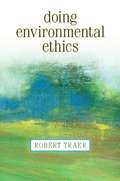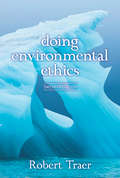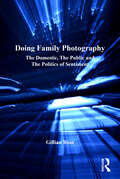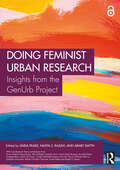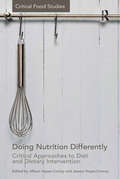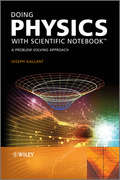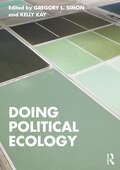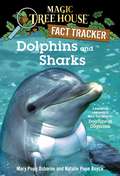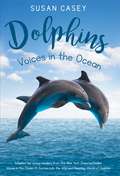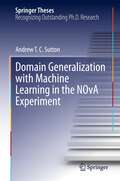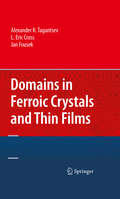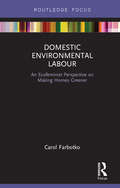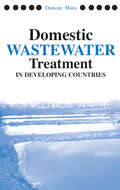- Table View
- List View
Do-It-Yourself Projects to Get You Off the Grid: Rain Barrels, Chicken Coops, Solar Panels, and More
by Noah WeinsteinInstructables is back with this inspiring book focused on a series of projects designed to get you thinking creatively about going green. Twenty Instructables illustrate just how simple it can be to make your own backyard chicken coop, or turn a wine barrel into a rainwater collector. Here, you will learn to: • Clip a chicken’s wings • Power your lawn mower with solar power • Create a chicken tractor for the city • Water your garden with solar power • Build a thermoelectric lamp • Create an algae bioreactor from water bottles • And much more! Illustrated with dozens of full-color photographs per project accompanying easy-to-follow instructions, this Instructables collection utilizes the best that the online community has to offer, turning a far-reaching group of people into a mammoth database churning out ideas to make life better, easier, and, in this case, greener, as this volume exemplifies.
Doable Renewables: 16 Alternative Energy Projects for Young Scientists
by Mike RigsbyKids will learn valuable hands-on lessons from this guide by constructing working models that generate renewable, alternative energy. Budding scientists learn how to build their own Kelvin water-drop generator out of six recycled cans and alligator-clip jumpers; a solar-powered seesaw from a large dial thermometer and a magnifying glass; and a windmill from eight yardsticks, PVC pipe, cardboard, and a converter generator. Children will investigate the energy-generating properties of a solar cell, a radiometer, a Nitinol heat engine, and a Peltier cell--there are even plans to build a human-powered desk lamp. Each project includes a materials and tools list as well as online information on where to find specialized components.
Docklands: Urban Change And Conflict In A Community In Transition
by Janet FosterThis text is a sociological study of a community in transition and the impact of urban regeneration. The process of change on the Isle of Dogs is revealed from the differing perspectives of Islanders, developers and business, and yuppies attracted to the area. The book is intended for undergraduate and postgraduate courses in urban sociology, social geography, cultural and community studies, housing and urban planning, race and ethnic studies, and broader market including Open University courses, "A"-level courses and general interest.
Doctrines Of Development
by M. P. CowenDoctrines of Development sets out a critique of the idea of practice of development by exploring the history of development theory and action from the early nineteenth century to the late twentieth century, from Britain to Quebec and Kenya.
Dodging Extinction
by Dr Anthony D. BarnoskyPaleobiologist Anthony D. Barnosky weaves together evidence from the deep past and the present to alert us to the looming Sixth Mass Extinction and to offer a practical, hopeful plan for avoiding it. Writing from the front lines of extinction research, Barnosky tells the overarching story of geologic and evolutionary history and how it informs the way humans inhabit, exploit, and impact Earth today. He presents compelling evidence that unless we rethink how we generate the power we use to run our global ecosystem, where we get our food, and how we make our money, we will trigger what would be the sixth great extinction on Earth, with dire consequences. Optimistic that we can change this ominous forecast if we act now, Barnosky provides clear-cut strategies to guide the planet away from global catastrophe. In many instances the necessary technology and know-how already exist and are being applied to crucial issues around human-caused climate change, feeding the world's growing population, and exploiting natural resources. Deeply informed yet accessibly written, Dodging Extinction is nothing short of a guidebook for saving the planet.
Does Water Flow Influence Everglades Landscape Patterns?
by Committee on Restoration of the Greater Everglades EcosystemThe report evaluates a White Paper written by restoration planners in South Florida on the role of water flow in restoration plans. The report concludes that there is strong evidence that the velocity, rate, and spatial distribution of water flow play important roles in maintaining the tree islands and other ecologically important landscape features of the Everglades.
Dog's Devotion: True Adventures of a K9 Search and Rescue Team
by Suzanne Elshult James Guy MansfieldIn late March of 2014, death descended upon the community of Oso, Washington, in the form of a massive landslide. Ten million cubic yards of dirt and mud crashed through homes, sweeping a 20-foot-high wall of debris before it and scouring the valley floor. In the cold rain of that morning, an entire community disappeared in a sea of mud. In the desperate hours that followed, rescue crews were able to pull only eight survivors out of the wrecked landscape. And then all became quiet, with the stunned realization that many more people were missing, but none were still living.This is the moment when the story of A Dog's Devotion begins. The emergency call from Oso went out and was answered by K9 Search and Rescue (SAR) teams from across the Pacific Northwest. Suzanne, along with her four-year-old Labrador Retriever, Keb, and her teammate Guy, was one of the SAR teams to respond to this disaster. In this book, readers immediately find themselves on the ground in the cold mud of the Oso Landslide Disaster on the desperate search for the remains of over forty lost souls. In subsequent chapters, readers will accompany Suzanne, Guy, and Keb as they are inserted by helicopter to search high snowfields on Mount Rainier or as they traverse steep, forested slopes searching for the clandestine grave of murder victims. They&’ll join K9 Keb as her keen nose leads to human remains in the forests of Washington State and as far away as the woods of Scandinavia. Keb&’s story is of a dedicated K9 who can distinguish the scent of the dead from the scent of the living, and who can detect buried bones and even corpses underwater. Readers will follow this intrepid K9 and her teammates as they face the challenges of changeable weather, deep northwest forests, high mountain slopes, and menacing coyotes to find dead bodies, missing hikers, and even the bones of murder victims from long ago. Among their successes: finding multiple victims buried by the 2014 Oso Landslide, solving the mysterious disappearance of women in wealthy suburbs, and finding human bones thought to be forever lost to time. It&’s their story about evolving as search and rescue volunteers while overcoming harsh conditions, inner demons, a rust-bound bureaucracy, and back-stabbing teammates. While internal conflicts threaten their larger K9 team, Keb&’s training, loyalty, and perseverance inspire them and help them find the resolve to carry on their service to the community.
Doing Business in the Middle East: A Research-Based Practitioners’ Guide
by Pawan Budhwar Vijay PereiraThe Middle East has for a long time been at the centre of global trade as well as political interest. Demographic and social change shifts in global economic power, rapid urbanisation, climate change and resource scarcity, and significant technological development make this region both complex and hugely important. Doing Business in the Middle East highlights both the opportunities and constraints confronting foreign investors in the region and proposes strategies on how best to overcome them. The book explores the existing and emerging political and legal frameworks, sociocultural patterns, national infrastructures, regulatory environment, conflict resolution and how to negotiate in the Middle East. It also provides useful insights into how to approach advertising and marketing, promotion and distribution, and also at the strategies for investing in the region and appropriate modes of entry. With a number of features such as case studies, examples of effective and ineffective practices, clear takeaways, and a note on a future agenda on each given topic, this book is highly practical. Based on robust research, this comprehensive guide to doing business in the Middle East is an ideal reference tool for potential foreign investors, those who are already doing business or intend to do so in the region, and for a range of business and policy decision-makers. The book is also suitable for students and researchers in the fields of international management and business, international and strategic HRM, cross-cultural management, and business communication.
Doing Children’s Geographies: Methodological Issues in Research with Young People
by Lorraine Van Blerk Mike KesbyDoing Children’s Geographies provides a useful resource for all those embarking on research with young people. Drawing on reflections from original cutting-edge research undertaken across three continents, the book focuses on the challenges researchers face when working with children, youth and their families. The book is divided into three sections. The first section provides alternatives to some of the difficulties researchers face and highlights methodological innovations as geographers uncover new and exciting ways of working. The second part specifically addresses the issues surrounding children and youth’s participation providing critiques of current practice and offering alternatives for increasing young people’s involvement in research design. Finally, the book broadens to a consideration of wider areas of concern for those working with children and youth. This section discusses the nature of childhood in relation to research, the place of emotions in research with young people and the process of undertaking applied research. This book was previously published as a special issue of Children's Geographies
Doing Community-Based Research: Perspectives from the Field
by Laura Ryser Don Manson Sean Markey Greg Donald Harman Akenson Halseth Donald Harman Akenson Donald Harman AkensonCommunity-based research (CBR) offers useful insights into the challenges associated with conducting research and ensuring that it generates both excellent scholarship and positive impacts in the communities where the research takes place. This depends on two important variables: the capacity of CBR to generate good information, and the extent to which CBR is understood and constructed as a two-way relationship that includes a set of responsibilities for both researchers and communities. Offering expert advice on the crucial relationship between communities and researchers, the authors outline the main stages of the CBR process to guide researchers and practitioners. They discuss the reasons for conducting CBR, provide tips on how to design research, detail how researchers and communities should get to know one another, as well as how best to work in the field, and how to turn fieldwork into research that counts. By focusing on the lessons learned from the use of CBR, the authors make the messages, lessons, and practices applicable to a variety of research settings. Drawing collectively from decades of community-based research experience and including vignettes from researchers from around the world who share their CBR experiences, Doing Community-Based Research is an essential handbook for scholars, students, and practitioners.
Doing Community-Based Research: Perspectives from the Field
by Laura Ryser Don Manson Sean Markey Greg HalsethGuidance on the community-researcher relationship, to support further scholarship and positive community change.
Doing Cultural Geography (Doing Geography series)
by Dr Pamela Shurmer-SmithDoing Cultural Geography is an introduction to cultural geography that integrates theoretical discussion with applied examples. The emphasis throughout is on doing. Recognising that many undergraduates have difficulty with both theory and methods courses, the text demystifies the 'theory' informing cultural geography and encourages students to engage directly with theory in practice. It emphasises what can be done with humanist, Marxist, post-structuralist, feminist, and post-colonial theory, demonstrating that this is the best way to prompt students to engage with the otherwise daunting theoretical literature. Twenty short chapters are grouped into five sections on Theory, Topic Selection, Methodology, Interpretation and Presentation. The main text is intercut with questions, suggestions for activities and short sample extracts from scholarly texts, chosen to exemplify the subject of the chapter and to stimulate further reading. Chapters conclude with glossaries and suggestions for further reading. Doing Cultural Geography will facilitate project work from small, classroom-based activities to the planning stages of undergraduate research projects. It will be essential reading for students in modules in cultural geography and foundation courses in human geography and theory and methods.
Doing Environmental Ethics
by Robert TraerDoing Environmental Ethics faces our ecological crisis by drawing on environmental science, economic theory, international law, and religious teachings, as well as philosophical arguments. It engages students in constructing ethical presumptions based on arguments for duty, character, relationships, and rights, and then tests these moral presumptions by predicting the likely consequences of acting on them. Students apply what they learn to policy issues discussed in the final part of the book: sustainable consumption, environmental policy, clean air and water, agriculture, managing public lands, urban ecology, and climate change. Questions after each chapter and a worksheet aid readers in deciding how to live more responsibly. The second edition has been updated to reflect the latest developments in environmental ethics, including sustainable practices of corporations, environmental NGO actions, and rainforest certification programs. This edition also gives greater emphasis to environmental justice, Rawls, and ecofeminism. Revised study questions concern application and analysis, and new "Decisions” inserts invite students to analyze evaluate current environmental issues.
Doing Environmental Ethics
by Robert TraerDoing Environmental Ethics faces our ecological crisis by drawing on environmental science, economic theory, international law, and religious teachings, as well as philosophical arguments. It engages students in constructing ethical presumptions based on arguments for duty, character, relationships, and rights, and then tests these moral presumptions by predicting the likely consequences of acting on them. Students apply what they learn to policy issues discussed in the final part of the book: sustainable consumption, environmental policy, clean air and water, agriculture, managing public lands, urban ecology, and climate change. Questions after each chapter and a worksheet aid readers in deciding how to live more responsibly. The second edition has been updated to reflect the latest developments in environmental ethics, including sustainable practices of corporations, environmental NGO actions, and rainforest certification programs. This edition also gives greater emphasis to environmental justice, Rawls, and ecofeminism. Revised study questions concern application and analysis, and new "Decisions” inserts invite students to analyze evaluate current environmental issues.
Doing Family Photography: The Domestic, The Public and The Politics of Sentiment (Re-materialising Cultural Geography Ser.)
by Gillian RoseFamily photography, a ubiquitous domestic tradition in the developed world, is now more popular than ever thanks to the development of digital photography. Once uploaded to PCs and other gadgets, photographs may be stored, deleted, put in albums, sent to relatives and friends, retouched, or put on display. Moreover, in recent years family photographs are more frequently appearing in public media: on posters, in newspapers and on the Internet, particularly in the wake of disasters like 9/11, and in cases of missing children. Here, case study material drawn from the UK offers a deeper understanding of both domestic family photographs and their public display. Recent work in material culture studies, geography, and anthropology is used to approach photographs as objects embedded in social practices, which produce specific social positions, relations and effects. Also explored are the complex economies of gifting and exchange amongst families, and the rich geographies of domestic and public spaces into which family photography offers an insight.
Doing Feminist Urban Research: Insights from the GenUrb Project
by Linda Peake Nasya S. Razavi Araby SmythDoing Feminist Urban Research introduces the reader to the newly emerging 21st-century global landscape of feminist urban research. It showcases decolonising practices, partnerships and teamwork, new standards such as EDI, geo-ethnographic methodologies, software-enhanced qualitative data analysis, and knowledge mobilisation.This book delves into both the institutional and lived realities of the practice of feminist urban research for the 21st century via the insights of the GenUrb transnational research project. Through refection exercises based on real-life examples, it covers feminist methodologies and research techniques, critically examining the ‘feld’ through comparison and feminist geo-ethnographies. It guides readers through navigating the politics of decolonising research, working across diferences, and embracing feminist ethics and activism. The book also explores data through the practices of translation, data management, data analysis, and the use of NVivo. And it further introduces professional standards, including EDI, collaboration with partners, engagement in teamwork, the handling of crises, such as pandemics, and knowledge mobilisation, including utilising social media. Accompanying web resources will assist scholars and students with additional audio fles and documents.This book’s practical guidance will help those starting to contemplate and engage in qualitative feminist urban research as well as those teaching the practice and politics of research. It will appeal to practitioners in urban studies, geography, gender and women’s studies, sociology, anthropology, global studies, and development studies.The Open Access version of this book, available at www.taylorfrancis.com, has been made available under a Creative Commons Attribution-Non Commercial-No Derivatives (CC-BY-NC-ND) 4.0 license.
Doing Nutrition Differently: Critical Approaches to Diet and Dietary Intervention (Critical Food Studies)
by Jessica Hayes-Conroy Allison Hayes-Conroy'Hegemonic nutrition' is produced and proliferated by a wide variety of social institutions such as mainstream nutrition science, clinical nutrition as well as those less classically linked such as life science/agro-food companies, the media, family, education, religion and the law. The collective result is an approach to and practice of nutrition that alleges not only one single, clear-cut and consented-upon set of rules for 'healthy eating,' but also tacit criteria for determining individual fault, usually some combination of lack of education, motivation, and unwillingness to comply. Offering a collection of critical, interdisciplinary replies and responses to the matter of 'hegemonic nutrition' this book presents contributions from a wide variety of perspectives; nutrition professionals and lay people, academics and activists, adults and youth, indigenous, Chicana/o, Latina/o, Environmentalist, Feminist and more. The critical commentary collectively asks for a different, more attentive, and more holistic practice of nutrition. Most importantly, this volume demonstrates how this 'new' nutrition is actually already being performed in small ways across the American continent. In doing so, the volume empowers diverse knowledges, histories, and practices of nutrition that have been marginalized, re-casts the objectives of dietary intervention, and most broadly, attempts to revolutionize the way that nutrition is done.
Doing Physics with Scientific Notebook
by Joseph GallantThe goal of this book is to teach undergraduate students how to use Scientific Notebook (SNB) to solve physics problems. SNB software combines word processing and mathematics in standard notation with the power of symbolic computation. As its name implies, SNB can be used as a notebook in which students set up a math or science problem, write and solve equations, and analyze and discuss their results.Written by a physics teacher with over 20 years experience, this text includes topics that have educational value, fit within the typical physics curriculum, and show the benefits of using SNB.This easy-to-read text:Provides step-by-step instructions for using Scientific Notebook (SNB) to solve physics problems Features examples in almost every section to enhance the reader's understanding of the relevant physics and to provide detailed instructions on using SNB Follows the traditional physics curriculum, so it can be used to supplement teaching at all levels of undergraduate physics Includes many problems taken from the author's class notes and research Aimed at undergraduate physics and engineering students, this text teaches readers how to use SNB to solve some everyday physics problems.
Doing Political Ecology
by Gregory L. Simon Kelly KaySince its inception, the field of political ecology has served as a critical hub for inclusive and transformative environmental inquiry. Doing Political Ecology offers a distinctive entry point into this ever-growing field and argues that our scholarly “foundations,” today more than ever, comprise a cross-cutting latticework of research approaches and concepts.This volume brings together 28 leading scholars from a range of backgrounds and geographies, with contributions organized into 18 analytical lenses that highlight different approaches to critical environmental research and “ways of seeing” nature-society interactions. The book's contributors engage the breadth and depth of the field, recognizing a variety of roots and genealogies, and give ample voice to these rich and complementary lineages. This inclusive presentation of the field allows diverse theoretical and empirical approaches to intermingle in novel ways. Readers will emerge with a wide-ranging understanding of political ecology and will attain a diverse toolkit for evaluating human–environment interactions.Each chapter astutely grounds key methodological, theoretical, topical, and conceptual approaches that animate a range of influential, cutting-edge, and complementary ways of “doing” political ecology.
Dolphins and Sharks: A Nonfiction Companion to Magic Tree House #9: Dolphins at Daybreak (Magic Tree House Fact Tracker #9)
by Mary Pope Osborne Sal Murdocca Natalie Pope BoyceMagic Tree House Research Guides are now Magic Tree House Fact Trackers! Track the facts with Jack and Annie! When Jack and Annie got back from their adventure in Magic Tree House #9: Dolphins at Daybreak, they had lots of questions. Did dolphins ever live on land? How do dolphins communicate? How do sharks hunt for food? Which sharks are the most dangerous? Find out the answers to these questions and more as Jack and Annie track the facts. Filled with up-to-date information, photos, illustrations, and fun tidbits from Jack and Annie, the Magic Tree House Fact Trackers are the perfect way for kids to find out more about the topics they discovered in their favorite Magic Tree House adventures.From the Trade Paperback edition.
Dolphins: Voices in the Ocean
by Susan CaseyA thrilling journey into the spiritual, scientific and sometimes threatened world of dolphins. Based on Susan Casey's bestselling adult work Voices in the Ocean: A Journey into the Wild and Haunting World of Dolphins, this young readers adaptation, which includes an 8-page photo insert, explores the extraordinary world of dolphins in an interesting and accessible format that engages as well as entertains.Inspired by an encounter with a pod of spinner dolphins off the coast of Maui, author Susan Casey embarked on a two-year global adventure to study these remarkable beings. Casey details the extraordinary connection between dolphins and humans, including shared characteristics such as capacity for emotion, playfulness, sociability, and intelligence, the sophisticated navigation ability innate in dolphins, and the dangers they face from people who aim to profit by putting them in captivity or far worse. Includes an 8-page photo insert that offers a glimpse of these magical creatures in their natural habitat.
Domain Generalization with Machine Learning in the NOvA Experiment (Springer Theses)
by Andrew T.C. SuttonThis thesis presents significant advances in the use of neural networks to study the properties of neutrinos. Machine learning tools like neural networks (NN) can be used to identify the particle types or determine their energies in detectors such as those used in the NOvA neutrino experiment, which studies changes in a beam of neutrinos as it propagates approximately 800 km through the earth. NOvA relies heavily on simulations of the physics processes and the detector response; these simulations work well, but do not match the real experiment perfectly. Thus, neural networks trained on simulated datasets must include systematic uncertainties that account for possible imperfections in the simulation. This thesis presents the first application in HEP of adversarial domain generalization to a regression neural network. Applying domain generalization to problems with large systematic variations will reduce the impact of uncertainties while avoiding the risk of falsely constraining the phase space. Reducing the impact of systematic uncertainties makes NOvA analysis more robust, and improves the significance of experimental results.
Domains in Ferroic Crystals and Thin Films
by Alexander K Tagantsev L. Eric Cross Jan FousekAt present, the marketplace for professionals, researchers, and graduate students in solid-state physics and materials science lacks a book that presents a comprehensive discussion of ferroelectrics and related materials in a form that is suitable for experimentalists and engineers. This book proposes to present a wide coverage of domain-related issues concerning these materials. This coverage includes selected theoretical topics (which are covered in the existing literature) in addition to a plethora of experimental data which occupies over half of the book. The book presents experimental findings and theoretical understanding of ferroic (non-magnetic) domains developed during the past 60 years. It addresses the situation by looking specifically at bulk crystals and thin films, with a particular focus on recently-developed microelectronic applications and methods for observations of domains with techniques such as scanning force microscopy, polarized light microscopy, scanning optical microscopy, electron microscopy, and surface decorating techniques. "Domains in Ferroic Crystals and Thin Films" covers a large area of material properties and effects connected with static and dynamic properties of domains, which are extremely relevant to materials referred to as ferroics. In other textbooks on solid state physics, one large group of ferroics is customarily covered: those in which magnetic properties play a dominant role. Numerous books are specifically devoted to magnetic ferroics and cover a wide spectrum of magnetic domain phenomena. In contrast, "Domains in Ferroic Crystals and Thin Films" concentrates on domain-related phenomena in nonmagnetic ferroics. These materials are still inadequately represented in solid state physics textbooks and monographs.
Domestic Environmental Labour: An Ecofeminist Perspective on Making Homes Greener (Routledge Explorations in Environmental Studies)
by Carol FarbotkoThis book addresses the question of domestic environmental labour from an ecofeminist perspective. A work of cultural geography, it explores the proposition that the practice and politics of domestic labour being undertaken in the name of ‘the environment’ needs to be better recognized, understood and accounted for as a phenomenon shaped by, and shaping of, gender, class and spatial relations. The book argues that a significant yet neglected phenomenon worthy of research attention is the upsurge in voluntary, and yet mostly unrecognized, domestic environmental labour in high-consuming households in late modernity, with the burden often falling on women seeking to green their lives and homes in aid of a sustainable planet. Further, because domestic environmental labour is undervalued in governance and the formal economy, much like other types of domestic labour, householders have become an unrecognized and unaccounted-for supply of labour for the greening of capitalism. Situated within broad global debates on links between ecological and social change, the book has relevance in the many jurisdictions around the world in which households are positioned as sites of environmental protection through green consumption. The volume engages existing interest in household environmental behaviour and practice, advancing understanding of these topics in new ways.
Domestic Wastewater Treatment in Developing Countries
by Duncan MaraAffordable and effective domestic wastewater treatment is a critical issue in public health and disease prevention around the world, particularly so in developing countries which often lack the financial and technical resources necessary for proper treatment facilities. This practical guide provides state-of-the-art coverage of methods for domestic wastewater treatment and provides a foundation to the practical design of wastewater treatment and re-use systems. The emphasis is on low-cost, low-energy, low-maintenance, high-performance 'natural' systems that contribute to environmental sustainability by producing effluents that can be safely and profitably used in agriculture for crop irrigation and/or in aquaculture, for fish and aquatic vegetable pond fertilization. Modern design methodologies, with worked design examples, are described for waste stabilization ponds, wastewater storage and treatment reservoirs; constructed wetlands, upflow anaerobic sludge blanket reactors, biofilters, aerated lagoons and oxidation ditches. This book is essential reading for engineers, academics and upper-level and graduate students in engineering, wastewater management and public health, and others interested in sustainable and cost-effective technologies for reducing wastewater-related diseases and environmental damage.
